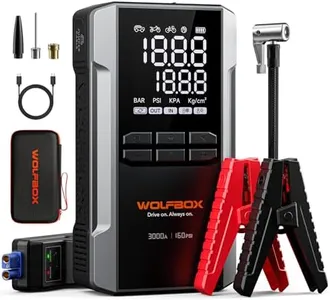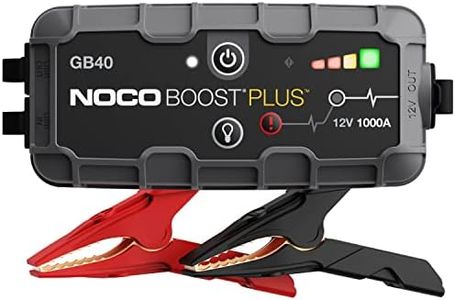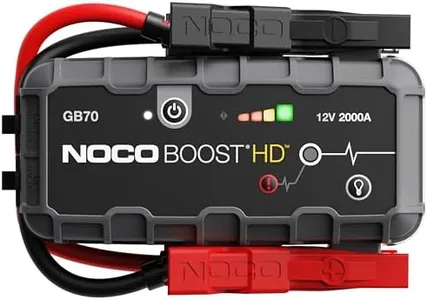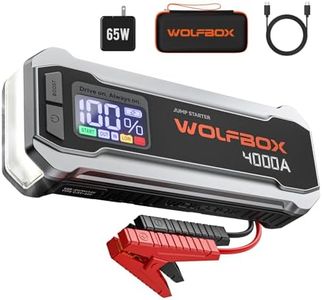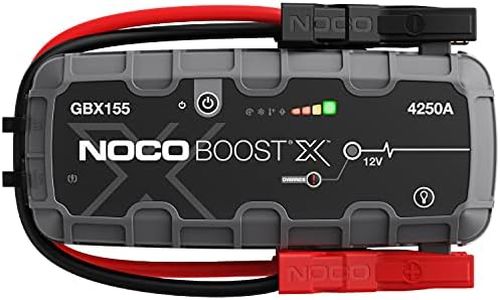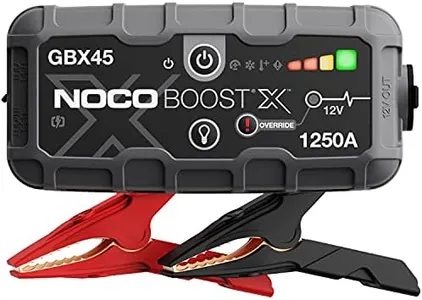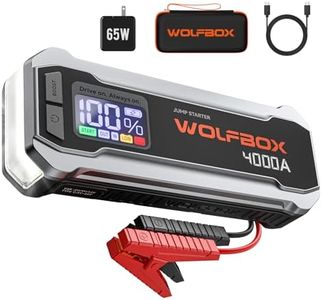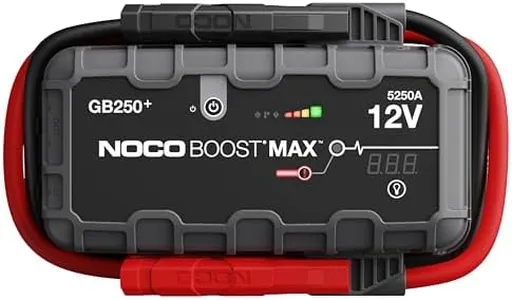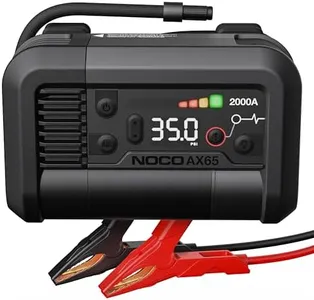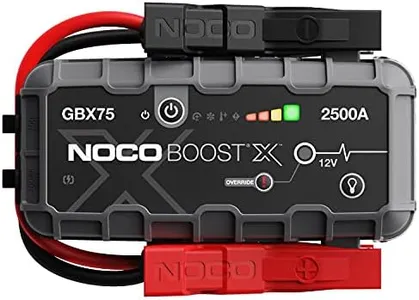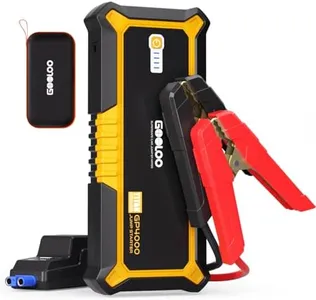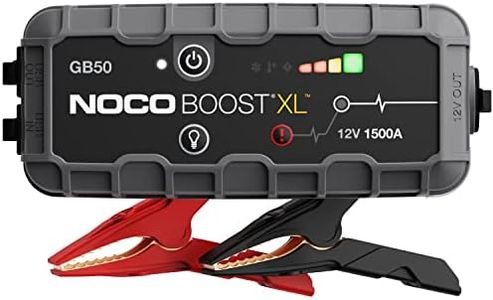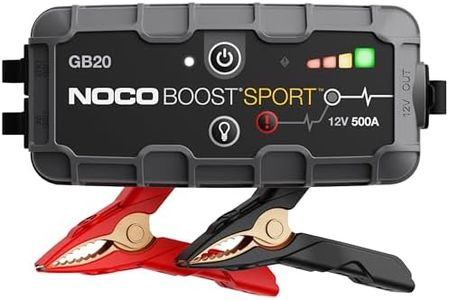10 Best Jump Starters 2025 in the United States
Recommended lists
Our technology thoroughly searches through the online shopping world, reviewing hundreds of sites. We then process and analyze this information, updating in real-time to bring you the latest top-rated products. This way, you always get the best and most current options available.

Our Top Picks
Winner
NOCO Boost GB40: 1000A UltraSafe Jump Starter – 12V Lithium Battery Booster Pack, Portable Jump Box, Power Bank & Jumper Cables - for 6.0L Gas and 3.0L Diesel Engines
Most important from
115598 reviews
The NOCO Boost Plus GB40 is a robust jump starter that stands out for its combination of power and portability. With a peak output of 1000 amps, it can jump-start both gasoline engines up to 6.0L and diesel engines up to 3.0L, making it highly versatile for various vehicles. Its lithium battery allows for up to 20 jump starts on a single charge, which is impressive and convenient for users who may face dead battery situations frequently.
One of the key strengths of the NOCO GB40 is its safety features. The design includes spark-proof technology and reverse polarity protection, ensuring that even those not familiar with jump starting can use it safely. This makes it a great choice for anyone looking for a reliable product without the stress of incorrect connections.
In addition to its jump-starting capabilities, this product doubles as a portable power bank, allowing you to charge phones and tablets on the go, which can be a real lifesaver during road trips or emergencies. The integrated LED flashlight with multiple modes adds another layer of utility, especially in low-light situations. However, there are a couple of aspects to consider. While its compact design (weighing only 2.5 pounds) enhances portability, it may not be as powerful as larger traditional jump starters, especially for larger vehicles or extreme conditions. Additionally, the recharge time of about 3 hours could feel lengthy for those in a hurry. Durability-wise, it boasts a rugged, water-resistant casing rated at IP65, which is great for outdoor use. However, some users might find the price on the higher side compared to simpler options that do not offer as many features. The NOCO Boost Plus GB40 is an excellent choice for those needing a safe, versatile, and portable jump starter that also functions as a power bank, while considering its capacity against their specific vehicle needs.
Most important from
115598 reviews
NOCO Boost GB70: 2000A UltraSafe Jump Starter – 12V Lithium Battery Booster Pack, Portable Jump Box, Power Bank & Jumper Cables - for 8.0L Gas and 6.0L Diesel Engines
Most important from
27153 reviews
The NOCO Boost HD GB70 is a powerful car battery jump starter that excels in various aspects crucial to its category. With its impressive peak output of 2000 amps, it can jump-start both gasoline engines up to 8.0 liters and diesel engines up to 6.0 liters, making it suitable for a wide range of vehicles. The battery holds enough charge for up to 40 jump starts, which is a significant benefit for those who may find themselves in need of assistance frequently.
Portability is a strong suit for the GB70 as it weighs just 5 pounds and has a compact design, making it easy to store in your vehicle or carry around. The device also includes a built-in LED flashlight with various modes, including emergency settings, adding to its versatility. The feature that sets this jump starter apart is its advanced safety design, which includes spark-proof technology and reverse polarity protection. This means that users can connect it without worrying about making mistakes that could lead to damage or injury.
There are a few drawbacks to consider. While the GB70 has a rugged and water-resistant construction, users who need a jump starter for extreme weather conditions may want to explore options with even higher ratings. Additionally, while it doubles as a portable power bank, the charging speed for USB devices could be improved as it takes 6 hours to recharge fully.
Most important from
27153 reviews
WOLFBOX 4000A Jump Starter,12V Car Battery Jump Starter with 65W Quick Charger,LED Display,24000mAh Portable Jump Starter Battery Pack(10L Gas 10L Diesel Engine) with Booster,LED Light,Jumper Cables
Most important from
2170 reviews
The WOLFBOX 4000A Jump Starter is a strong contender in the jump-starter category, particularly for users needing a reliable way to power up vehicles with up to 10L engines, whether they are gasoline or diesel. With a robust 24000mAh battery, it delivers a peak output of 4000 amps, allowing it to quickly jump-start larger vehicles like trucks and boats, which is a significant advantage in emergency situations.
Portability is another strong point; weighing just 2.9 pounds and featuring compact dimensions, it’s easy to store in your vehicle or carry around. Additionally, the quick charging capability through a 65W USB-C port means you can have it ready to go in just over an hour, making it practical for both everyday and travel use.
The inclusion of an HD LCD display is a great feature, providing clear status updates on battery life and charge, which adds to the user-friendliness. Furthermore, the device is equipped with an LED flashlight that can be invaluable in emergencies, offering various modes such as SOS and strobe, enhancing its functionality beyond just jump-starting. On the downside, while it boasts an IP64 rating for dust and water resistance, some users may still find concerns about durability in extremely harsh environments. Moreover, while the safety features are comprehensive, ensuring protection against sparks and temperature extremes, the effectiveness of these features may vary based on usage conditions. Lastly, while it effectively charges devices like phones and laptops, its size may not be the most compact option for those prioritizing extreme portability.
The WOLFBOX 4000A is a powerful, feature-rich jump starter that is well-suited for those who need a dependable tool for larger vehicles or outdoor adventures, offering a good balance of portability and performance. Potential buyers should consider their specific durability needs and whether they prefer a more compact option for ease of transport.
Most important from
2170 reviews
Buying Guide for the Best Jump Starters
Choosing the right jump starter can be a lifesaver in emergency situations when your vehicle's battery dies. A jump starter is a portable device that provides the necessary power to start your car without needing another vehicle. When selecting a jump starter, it's important to consider several key specifications to ensure it meets your needs and is reliable when you need it most.FAQ
Most Popular Categories Right Now
